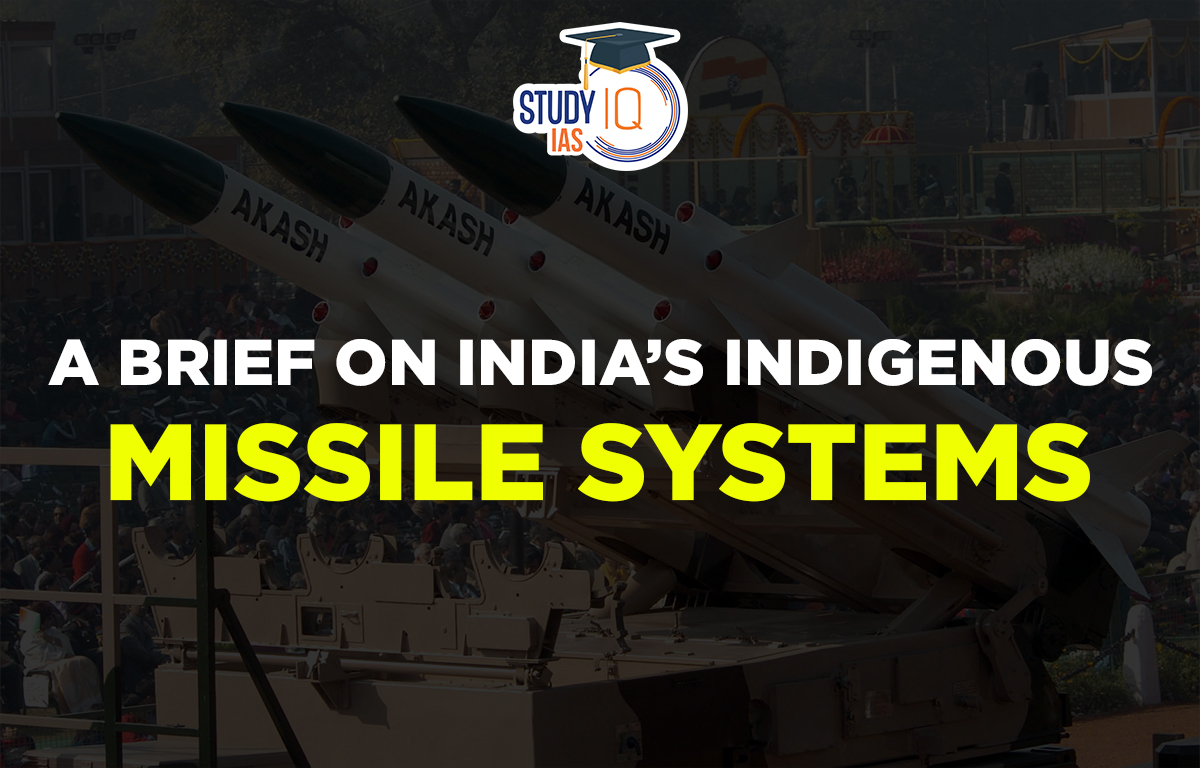Context: Recently, Indian Army said that indigenously developed equipment like Arjun Tank, Nag Missile System, K9 Vajra, and Akash Weapon System under the Aatmanirbhar Bharat Abhiyan will be showcased during the Republic Day parade on the 26th of January at Kartavya Path.
India’s Indigenous Missile Systems Highlights
Defence System: Arjun Tank
- Arjun main battle tank (MBT), named after the warrior prince Arjuna in the Indian epic Mahabharata, was developed by the Defence Research and Development Organisation (DRDO) for the Indian Army.
- It offers the troops a state-of-the-art tank with superior firepower, high mobility, and excellent protection by adopting most advanced technologies.

Arjun Mk1 Variant: Mk1A and MkII.
- Arjun’s Mark-1A: It is a new variant of Arjun Tank designed to enhance fire power, mobility and survivability.
- Mark-1A variant adds 72 new features — 14 major and 58 minor — to the previous variant Mark-1.
- These additions have resulted in better all-terrain mobility and manoeuvrability in different modes of operation, better target acquisition,
- and precision firing during both day and night with a 360° view, and a multi-layered robust protective armour named ‘Kanchan’.
- Arjun MkII variant: It is a light-weight futuristic main battle tank (FMBT) with electro-optical sensors and high-power lasers.
- Arjun MkII variant is seen as a potential replacement for the Army’s ageing Russian T-72 fleet of 2,400 tanks.
Nag Missile System,
- NAG (meaning Cobra) is an anti-tank guided missile developed by Defence Research and Development Organisation (DRDO) under the integrated guided missile development programme (IGMDP).
- IGMDP also includes four other missiles — Agni, Akash, Trishul and Prithvi.
- It is a Indian third-generation, all-weather, fire-and-forget, lock-on after launch, top-attack, anti-tank guided missile with an operational range of 500 metres to 7000 metres km with the potential of being developed in future versions to 20,000 metres.
Nag Variants
NAMICA (Nag Missile Carrier): It is a land version meant for infantry, can be launched from a tracking-cum-launch vehicle.
- The launch system is mounted on light infantry vehicle BMP-2 and can carry up to six missiles. Each launcher can fire four missiles in one minute.
- Helina (7-10km): It is a helicopter-launched version of NAG with an extended range.
- The launch system is mounted on HAL “Rudra” helicopter using “Rudrastra” twin-launcher system and HAL Light Combat Helicopters.
- The launch system is used by both Indian Army and Air Force.
- Helina (SANT) (15-20 km): This is an upgraded version of the third-generation Helina with an extended range.
- The higher range and a new nose-mounted radar seeker help the missile launch platform stay at a safe distance, to evade enemy fire.
- Man Portable Anti-tank Guided Missile (MPATGM): This version is lighter (14.5 kg) in comparison to other variants and can be launched from the shoulder.
- It has a strike range of 2.5 km.

K9 Vajra
- It is a 155 mm, 52-calibre tracked self-propelled howitzer built by L&T with technology transferred from South Korean defence major Hanwha Defense based on its K9 Thunder.
- The gun being manufactured for India is called the K9 Vajra-T, where T stands for ‘tank’.
- Globally, it’s called the K9 Thunder, whereas the one built for India is called the K9 Vajra, and has been optimized for desert operation.
- It’s a self-propelled artillery system, meaning that it doesn’t need to be towed behind an artillery truck like the Bofors 155mm cannon or the M777 howitzer.

Akash Weapon System
- Akash is the first indigenous state-of-the-art surface-to-air missile (SAM) system.
- Development of the Akash SAM was started by the DRDO in the late 1980s as part of the Integrated Guided Missile Development Programme.
- AKASH is a Short Range Surface to Air Missile System to protect vulnerable areas and points from air attacks.
- Akash weapon system can simultaneously engage multiple targets in group mode or autonomous mode.
- It has built-in Electronic Counter-Counter Measures (ECCM) features, which means that it has mechanisms on-board that can counter the electronic systems that deceive the detection systems.
- A full Akash missile system comprises a launcher, set of missiles, a control centre, an built-in mission guidance system and a C4I (command, control communication and intelligence) centres and supporting ground equipment along with a radar named Rajendra which accompanies each of the missile batteries.

- According to the Ministry of Defence, the Akash Missile system is 96 per cent indigenised, one of the highest proportions of the indigenisation.
Advanced Versions of Akash
- Akash Prime: It has an indigenous active Radio Frequency (RF) seeker for improved accuracy to hit aerial targets.
- It is more reliable under low temperature environments at higher altitudes.
- Akash-NG or New Generation :It is a new generation SAM, primarily designed for the IAF with an aim of intercepting high maneuvering aerial threats that have low Radar Cross Section (RCS), which is the electromagnetic signature of the object.
- NG version has an extended range of up 70 km, is sleeker, lighter and has much smaller ground system footprint.
- The RF seeker of the NG version operates in the Microwave Ku-band, the missile has a propulsion system of solid-fueled dual-pulse motor.
- Akash NG is canisterised, which means that it is stored and operated from specially designed compartments.


 Daily Quiz 05 July 2025
Daily Quiz 05 July 2025
 SSC MTS Apply Online for 1075 Posts – ...
SSC MTS Apply Online for 1075 Posts – ...
 Dynamic Pricing: What It Is and Why It's...
Dynamic Pricing: What It Is and Why It's...





















